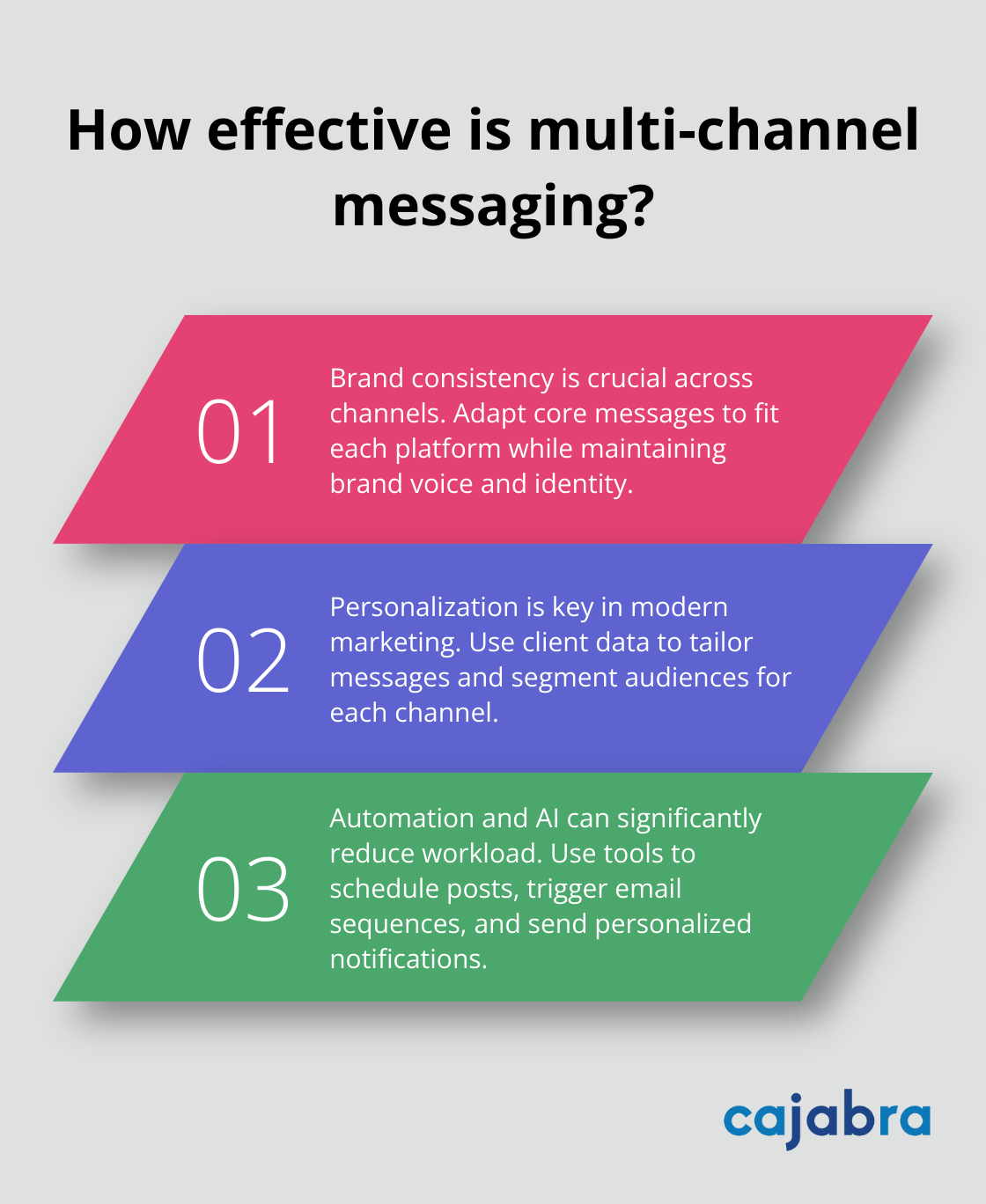
At Cajabra, LLC, we've seen firsthand how a multi-channel messaging strategy can transform customer engagement. In today's digital landscape, reaching audiences across various platforms is no longer optional-it's essential.
This blog post will explore the power of multi-channel messaging and provide practical tips for businesses looking to expand their reach. We'll cover key channels, best practices, and future trends to help you connect with your audience wherever they are.
Multi-channel messaging is a strategic approach to customer communication that uses multiple platforms to reach and engage audiences. This method acknowledges that consumers interact with brands across various touchpoints, including email, SMS, social media, and voice assistants.

The significance of multi-channel messaging in today's fragmented digital landscape cannot be overstated. 62% of marketers say that implementing a multichannel strategy is a top priority for their organization. This preference underscores the need for businesses to diversify their communication strategies to meet customers where they are.
A successful multi-channel messaging strategy relies on several critical components:
Audience Segmentation: Dividing your customer base into distinct groups based on demographics, behaviors, or preferences allows for tailored messages with maximum impact.
Message Consistency: While the format may change across platforms, the core brand message should remain cohesive. This consistency builds trust and reinforces brand identity, regardless of where customers encounter your communications.
Data Integration: Centralizing customer data from various sources creates a unified view of each customer's journey. This integration enables personalized messaging and more effective targeting across channels.
Multi-channel messaging offers substantial benefits for both businesses and consumers:
For Businesses:
Improved Customer Retention: Companies with omnichannel customer engagement strategies retain on average 89% of their customers, compared to 33% for companies with weak omni-channel strategies.
Revenue Growth: Customers who engage with brands across multiple channels have a higher lifetime value than those who stick to a single channel.
For Consumers:
Convenience and Choice: Consumers can interact with brands on their preferred platforms, whether that's responding to an email campaign or engaging with a chatbot on a company website.
Enhanced Customer Experience: This flexibility fosters loyalty and improves overall satisfaction.
While the benefits are clear, implementing a multi-channel strategy presents challenges:
Data Silos: Customer information often scatters across different departments or systems. Breaking down these silos is essential for creating a unified customer view and delivering consistent messaging.
Resource Allocation: Effective management of multiple channels requires time, expertise, and often, specialized tools. Businesses must carefully consider their capabilities and may need to invest in new technologies or training to fully leverage a multi-channel approach.
Despite these challenges, the potential rewards make multi-channel messaging a worthwhile investment for businesses aiming to enhance their customer engagement and drive growth in an increasingly digital world.
As we move forward, we'll explore the popular channels that form the backbone of effective multi-channel messaging strategies. Understanding these platforms is key to crafting a comprehensive approach that resonates with your target audience.
Email continues to be a powerhouse in multi-channel strategies, with an impressive ROI of $36 for every $1 spent. For accounting firms, email excels as a medium for sharing industry insights, tax updates, and personalized financial advice. To maximize email effectiveness:
Text messaging offers unparalleled open rates, with 98% of SMS messages read within three minutes of receipt. Accountants can use SMS for:

Obtain explicit consent before sending SMS messages and provide clear opt-out instructions to comply with regulations.
Social platforms allow accounting firms to showcase their expertise and engage with clients in a more informal setting. LinkedIn, in particular, stands out for B2B connections, with 79% of B2B marketers seeing it as a good source for generating leads. To leverage social media effectively:
With mobile devices accounting for over half of global web traffic, push notifications offer a direct line to users' attention. Accounting firms can use push notifications to:
To prevent notification fatigue, ensure each push delivers value and relevance to the recipient.
Apps like WhatsApp and Facebook Messenger have become increasingly popular for business communication (WhatsApp boasts over 2 billion active users worldwide). Accounting firms can use these platforms to:
When using instant messaging, establish clear boundaries for response times and professional conduct to maintain work-life balance.
As we explore these channels, it becomes clear that each offers unique advantages for reaching and engaging clients. The next section will discuss best practices for implementing these channels effectively in your multi-channel messaging strategy.
Brand consistency across channels is essential. Your message should be recognizable instantly, whether it's an email, a tweet, or a push notification. This doesn't mean using identical content everywhere. Instead, adapt your core message to fit each platform's unique characteristics while maintaining your brand voice and visual identity.

An accounting firm might share a tax-saving tip on Twitter in 280 characters, expand on it in a LinkedIn post, and provide in-depth details in an email newsletter. The underlying message and branding should remain consistent across all these touchpoints.
Generic, one-size-fits-all messaging is outdated. Today's consumers expect personalized experiences. Use the data you have on your clients to tailor your messages. This could mean segmenting your email list based on client type, sending SMS reminders for specific appointments, or using dynamic content in your social media ads.
A multi-channel strategy can be resource-intensive, but automation and AI can significantly reduce the workload. Use marketing automation tools to schedule posts across social media platforms, trigger email sequences based on user actions, and send personalized push notifications at optimal times.
Generative AI can automate marketing campaigns across multiple channels, ensuring consistent customer experiences. AI can analyze vast amounts of data to predict the best times to send messages, optimize subject lines, and even generate personalized content. AI-powered chatbots can handle initial client inquiries across multiple platforms, freeing up your team to focus on more complex tasks.
Digital channels provide a wealth of data. This data is only valuable if you use it to improve your strategy. Set clear KPIs for each channel and regularly analyze your performance against these metrics.
Examine engagement rates, conversion rates, and ROI for each channel. Identify which platforms drive the most valuable interactions and where you see the highest return on your investment. Use these insights to continuously refine your approach.
If you notice that your SMS campaigns have a higher open rate but lower conversion rate compared to email, you might need to adjust your SMS content strategy or reevaluate the types of messages you're sending through this channel.
As you expand your messaging across multiple channels, staying compliant with regulations becomes more complex-and more critical. Familiarize yourself with laws like GDPR, CCPA, and CAN-SPAM, which govern how you can collect, use, and store customer data across various platforms.
Implement clear opt-in and opt-out processes for each channel. Be transparent about how you'll use customer data and stick to your promises. This is not only legally required, but it also builds trust with your audience.
A single compliance misstep can undo months of careful brand building. Make compliance a cornerstone of your multi-channel strategy.
Multi-channel messaging has revolutionized customer engagement in the digital age. This approach enhances customer retention, boosts revenue growth, and provides a seamless experience across various platforms. The future of multi-channel communication will likely involve greater AI integration, more seamless customer journeys, and innovative technologies like voice-activated devices and augmented reality.

Businesses should start by understanding their target audience and preferred communication channels to implement an effective multi-channel messaging strategy. We at Cajabra specialize in helping accounting firms implement multi-channel marketing strategies that drive results. Our JAB System™ aims to move accountants from overlooked to overbooked in 90 days, leveraging the power of multi-channel messaging to secure retainer-based clients.
The benefits of a multi-channel messaging strategy outweigh the challenges. This approach creates meaningful connections with audiences, drives engagement, and achieves sustainable growth in the competitive digital landscape. Your customers are waiting to hear from you across multiple channels, so take action now to stay ahead of the curve.



